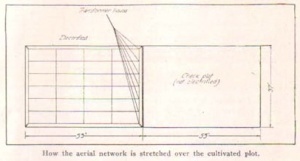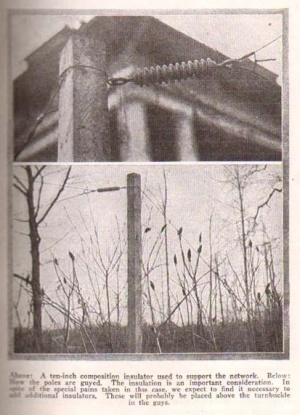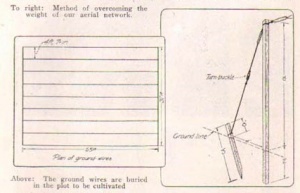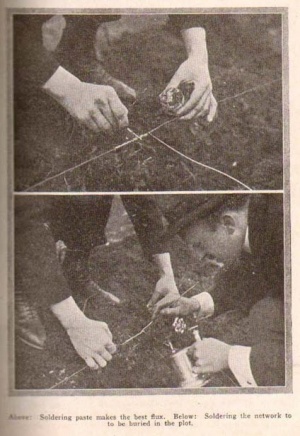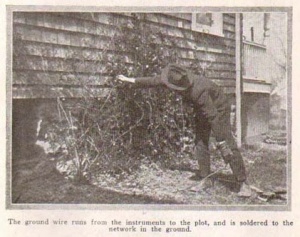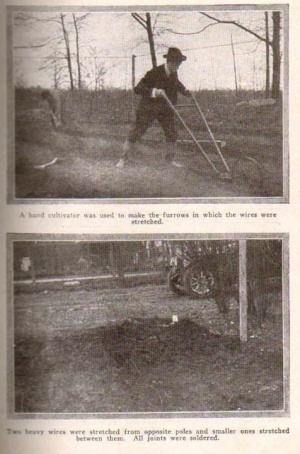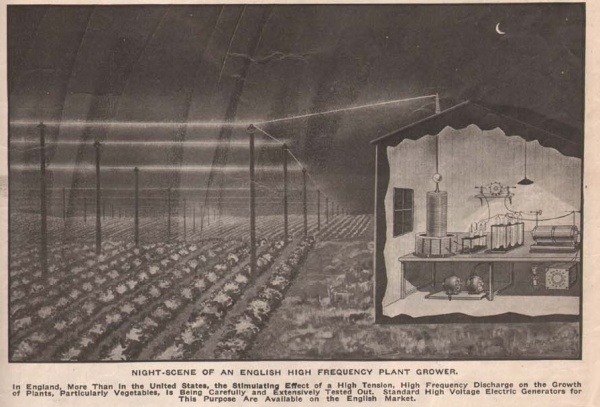Early Reading on Electroculture (1892 - 1922)
From Kook Science
The following articles form a brief, historical basis from which to continue our reading on electroculture— using electricity to improve plant growth.
ELECTRICITY IN AGRICULTURE (1892)
By CLARENCE D. WARNER. From "Scientific American Supplement. Vol. XXXIII, No. 841." (1892)
It is well known that currents of electricity exist in the atmosphere. Clouds are charged and discharged. There is a constant change of electricity from earth to air and from air to earth, the latter being the great reservoir for all electricity. Hills, mountain peaks, trees, high chimneys, spires, in fact all points elevated above the earth's surface assist greatly in charging and discharging the atmosphere. Again, if two iron rods are driven into the earth and connected by a copper wire with an electrometer in the circuit, the instrument is almost immediately affected, showing that currents of electricity are running through the ground. Now, what is the function of these atmospheric and ground electric currents? Many scientists are agreed that certain forms of precipitation are due to electrical action; but my observations have led me to believe conclusively that electricity is a potent factor in the economy of nature, and has more to do with the growth and development of plants than has hitherto been known. Davy succeeded in the decomposition of the alkalies, potash and soda, by means of electric currents. In our laboratories, water and ternary compounds are rapidly decomposed by the battery, and we may reasonably suppose that that which is effected in our laboratories by artificial means takes place in the great laboratory of nature on a grander and more extended scale.
Plant food is carried throughout the plant by means of the flow of sap; these currents circulate through all the rootlets and center, as it were, in the stalk, carrying their tiny burdens of various elements and depositing them in their proper places. That this phenomenon of circulation is due to electricity cannot be doubted. Most plants grow more rapidly during the night than in the day. May not the following be a reason for this?
We have already mentioned how electric currents pass from air to earth and vice versa; at night the plant is generally covered with dew and the plant itself becomes a good conductor, and, consequently, currents of electricity pass to each through this medium, and during the passage convert soil elements into plant food and stimulate the upward currents to gather up the dissolved elements and carry them to their proper places.
From the time electricity became a science, much research has been made to determine its effect, if any, upon plant growth. The earlier investigations gave in many cases contradictory results. Whether this was due to a lack of knowledge of the science on the part of the one performing the experiments, or some defect in the technical applications, we are not prepared to say; but this we do know, that such men as Jolabert, Nollet, Mainbray and other eminent physicists affirmed that electricity favored the germination of seeds and accelerated the growth of plants; while, on the other hand, Ingenhouse, Sylvestre and other savants denied the existence of this electric influence. The heated controversies and animated discussions attending the opposing theories stimulated more careful and thorough investigations, which establish beyond a doubt that electricity has a beneficial effect on vegetation. Sir Humphry Davy, Humboldt, Wollaston and Becquerel occupied themselves with the theoretical side of the question; but it was not till after 1845 that practical electroculture was undertaken. Williamson suggested the use of gigantic electrostatic machines, but the attempts were fruitless. The methods most generally adopted in experiments consisted of two metallic plates—one of copper and one of zinc—placed in the soil and connected by a wire. Sheppard employed the method in England in 1846 and Forster used the same in Scotland. In the year 1847 Hubeck in Germany surrounded a field with a network of wires. Sheppard's experiments showed that electricity increased the return from root crops, while grass perished near the electrodes, and plants developed without the use of electricity were inferior to those grown under its influence. Hubeck came to the conclusion that seeds germinated more rapidly and buckwheat gave larger returns; in all other cases the electric current produced no result. Professor Fife in England and Otto von Ende in Germany carried on experiments at the same time, but with negative results, and these scientists advised the complete abandonment of applying electricity to agriculture. After some years had elapsed Fichtner began a series of experiments in the same direction. He employed a battery, the two wires of which were placed in the soil parallel to each other. Between the wires were planted peas, grass and barley, and in every case the crop showed an increase of from thirteen to twenty-seven per cent when compared with ordinary methods of cultivation.
Fischer, of Waldheim, believing atmospheric electricity to aid much in the growth and development of plants, made the following tests:
He placed metallic supports to the number of about sixty around each hectare (2.47 acres) of loam; these supports were provided at their summits with electrical accumulators in the form of crowns surmounted with teeth. These collectors were united by metallic connection. The result of this culture applied to cereals was to increase the crop by half.
The following experiment was also tried: Metallic plates sixty-five centimeters by forty centimeters were placed in the soil. These plates were alternately of zinc and copper and placed about thirty meters apart, connected two and two, by a wire. The result was to increase from twofold to fourfold the production of certain garden plants. Mr. Fischer says that it is evidently proved that electricity aids in the more complete breaking up of the soil constituents. Finally he says that plants thus treated mature more quickly, are almost always perfectly healthy, and are not affected with fungoid growth.
Later, N. Specnew, inspired by the results arrived at by his predecessors, was led to investigate the influence of electricity on plants in every stage of their development; the results of his experiments were most satisfactory and of practical interest. He began by submitting different seeds to the action of an electric current, and found that their development was rendered more rapid and complete. He experimented with the seeds of haricot beans, sunflowers, winter and spring rye. Two lots, of twelve groups of one hundred and twenty seeds each, were plunged into water until they swelled, and while wet the seeds were introduced into long glass cylinders, open at both ends. Copper disks were pressed against the seeds, the disks were connected with the poles of an induction coil, the current was kept on for one or two minutes and immediately afterward the seeds were sown. The temperature was kept from 45° to 50° Fahrenheit, and the experiments repeated four times. The following table shows the results:
| Peas. Days. | Beans. Days. | Barley. Days. | Sunflowers. Days. | |
|---|---|---|---|---|
| Electrified seeds developed in | 2.5 | 3 | 2 | 8.5 |
| Non-electrified seeds developed in | 4 | 6 | 5 | 15 |
It was also observed that the plants coming from electrified seeds were better developed, their leaves were much larger and their color brighter than in those plants growing from non-electrified seeds. The current did not affect the yield.
At the Botanical Gardens at Kew, the following experiment was tried:
Large plates of zinc and copper (0.445 meter and 0.712 meter) were placed in the soil and connected by wires, so arranged that the current passed through the ground; the arrangement was really a battery of (zinc | earth | copper). This method was applied to pot herbs and flowering plants and also to the growing of garden produce; in the latter case the result was a large crop and the vegetables
grown were of enormous size.
Extensive experiments in electroculture were also made at Pskov, Russia. Plots of earth were sown to rye, corn, oats, barley, peas, clover and flax; around these respective plots were placed insulating rods, on the top of which were crown-shaped collectors—the latter connected by means of wires. Atmospheric electricity was thus collected above the seeds, and the latter matured in a highly electrified atmosphere; the plots were submitted to identical conditions and the experiments were carried on for five years. The results showed a considerable increase in the yield of seed and straw, the ripening was more rapid and the barley ripened nearly two weeks earlier with electroculture. Potatoes grown by the latter method were seldom diseased, only to 5 per cent., against 10 to 40 per cent. by ordinary culture.
Grandeau, at the School of Forestry at Nancy, found by experiment that the electrical tension always existing between the upper air and soil stimulated growth. He found plants protected from the influence were less vigorous than those subject to it.
Macagno, also believing that the passage of electricity from air through the vine to earth would stimulate growth, selected a certain number of vines, all of the same variety and all in the same condition of health and development. Sixteen vines were submitted to experiment and sixteen were left to natural influences. In the ends of the vines under treatment, pointed platinum wires were inserted, to which were attached copper wires, leading to the tops of tall poles near the vines; at the base of these same vines other platinum wires were inserted and connected by copper wires with the soil. At the close of the experiment, which began April 15, and lasted till September 16, the wood, leaves and fruit of both sets of vines were submitted to careful analysis with the following results:
| Without conductor. | With conductor. | |
|---|---|---|
| Moisture per cent. | 78.21 | 79.84 |
| Sugar. | 16.86 | 18.41 |
| Tartaric acid. | 0.880 | 0.791 |
| Bitartrate of potash. | 0.180 | 0.186 |
Thus we see that the percentage of moisture and sugar is greater and the undesirable acid lower in those vines subject to electrical influences than in those left to natural conditions. There are also experiments which prove the beneficial effects of electricity on vines attacked by phylloxera.
The following experiments were made at this station: Several plots were prepared in the greenhouse, all of which had the same kind of soil and were subjected to like influences and conditions. Frames in the form of a parallelogram, about three feet by two feet, were put together; across the narrow way were run copper wires in series of from four to nine strands, each series separated by a space about four inches wide, and the strands by a space of one-half inch. These frames were buried in the soil of the plot at a little depth, so that the roots of the garden plants set would come in contact with the wires, the supposition being that the currents of electricity passing along the wires would decompose into its constituents the plant food in the vicinity of the roots and more readily prepare it for the plants. Two electric gardens were thus prepared and each furnished with two common battery cells, so arranged as to allow continuous currents to pass through each series of wires. Near each electric garden was a plot prepared in the same manner, save the electrical apparatus. We will call the two gardens A and B.
The place chosen for the experiments was in a part of the greenhouse which is given up largely to the raising of lettuce, and the gardens were located where much trouble from mildew had been experienced. The reason for this choice of location was to notice, if any, the effect of electricity upon mildew, this disease being, as it is well known, a source of much trouble to those who desire to grow early lettuce. The soil was carefully prepared, the material taken from a pile of loam commonly used in the plant house.
Garden A was located where mildew had been the most detrimental; the experiments began the first of January and closed the first of April. For the garden, fifteen lettuce plants of the head variety were selected, all of the same size and of the same degree of vitality, as nearly as could be determined; the plants were set directly over the wires, so that the roots were in contact with the latter; the plants were well watered and cared for as in ordinary culture, and the fluid in the battery cells was renewed from time to time, that the current of electricity might not become too feeble. At the close of the experiments the following results were noted:
Five plants died from mildew, the others were well developed and the heads large. The largest heads were over the greatest number of wires and nearest the electrodes. It was further noticed that the healthiest and largest plants, as soon as the current became feeble or ceased altogether, began to be affected with mildew. On examining the roots of the plants it was found that they had grown about the wires as if there they found the greatest amount of nourishment; the roots were healthy and in no way appeared to have been injured by the current, but, rather, much benefited by the electrical influences.
Beside garden A was prepared another plot of the same dimensions, having the same kind of soil and treated in like manner as the first, but the electrical apparatus and wires were wanting. At the close of the experiments only three plants had partially developed, and two of these were nearly destroyed by mildew—one only was free from the disease. The results, therefore, show that the healthiest and largest plants grew in the electric plot.
In the second experiment, which we called B, twenty plants of the same variety of lettuce and of equal size were taken. The treatment given was the same as the plants in plot A received. Five plants only remained unaffected with mildew; seven died from the disease when they were half grown; the rest were quite well developed, but at the last part of the experiment began to be affected. Several heads were large, the largest being over the greatest number of wires and nearest the electrodes. Examination of the roots disclosed the same phenomena as in A.
Near plot B were also set twenty other plants, subjected to like conditions as the first, but without electricity; all but one died from mildew before they were half grown, the solitary plant that survived being only partly developed at the close of the experiment, and even this was badly affected with the disease.
Everything considered, the results were in favor of electricity. Those plants subjected to the greatest electrical influence were hardier, healthier, larger, had a better color, and were much less affected by mildew than the others. Experiments were made with various grasses, but no marked results were obtained.
The question would naturally arise whether there may not be a limit reached where electricity would completely overcome the attack of mildew and stimulate the plant to a healthy and vigorous condition throughout its entire growth. From the fact that the hardiest, healthiest, and largest heads of lettuce grew over the greatest number of currents and nearest the electrodes, it would seem that electricity is one of the agents employed by nature to aid in supplying the plant with nourishment and to stimulate its growth. To what extent plants may be submitted to electrical influence, or what strength of current is best suited to them and what currents prove detrimental to their development, have not been determined as yet, but it is desirable to continue this research until some definite information shall be gained on these points. Probably different varieties of plants differ greatly in their capacity for enduring the action of electric currents without injury—experiment alone must determine this.
It has been proved that the slow discharge of static electricity facilitates the assimilation of nitrogen by plants. Faraday showed that plants grown in metallic cages, around which circulated electric currents, contained 50 per cent. less organic matter than plants grown in the open air. It would seem from the researches of the latter physicist that those plants requiring a large percentage of nitrogen for their development would be remarkably benefited if grown under electric influence.—Massachusetts Agricultural College, Bulletin No 16.
[A very interesting article on the Influence of Electricity upon Plants, illustrated, is given in SUPPLEMENT 806. It presents the results of the studies of Prof. Lemstrom, of Helsingfors.]
Cultivating Vegetables With Electricity (1917)
by Thomas Stanley Curtis (Everyday Engineering, June 1917)
"Let me suggest also that every one who creates or cultivates a garden helps, and helps greatly, to solve the problem of the feeding of the Nations."—Woodrow Wilson
Every radio telegraphic transmitter, large or small, amateur or professional, is a potential cultivator of plant life. Through a simple conversion of the oscillation transformer, the apparatus to be found in the possession of every licensed radio amateur can be made to perform this practical service in connection with the so-called "kitchen gardens" springing up all over the country.
Following this line of reasoning, Mr. F. F. Pickslay, an ardent experimentalist of Mamaroneck, N.Y., called at the offices of this magazine a few weeks ago and made known his plans, which were formulated largely as a natural result of the order to dismantle all radio stations. The net result of the conference is that Mr. Pickslay will collaborate with the Laboratory Staff of EVERYDAY ENGINEERING to conduct of a line of serious experiments made on the plot adjoining his residence at 24 Tenny Avenue in Mamroneck, which is situated a short train ride from New York City.
The entire stretch of ground being planted measures 38 ft. front by 110 ft. deep. This plot is divided into two parts, one of which will be electrified, and the other without current, for purposes of checking results obtained.
THE DISTRIBUTING SYSTEM
The system for distribution of the high-tension, high-frequency current is simple. It comprises essentially a net-work of copper wire suspended above the garden at a distance of some 8 ft. from the ground, and a series of copper wires placed in shallow trenches beneath the ground.
In the case of our garden, the placing of the ground wires was a simple matter. The plot was first plowed, then raked, and finally the ground wires were placed in furrows produced by means of a hand plow or cultivator of the kind sold in nearly every country hardware store. The ground wires, nine in number, were bridged at either end with a piece of heavy stranded copper wire. All joints were soldered before the wires were buried. The ground lead is a piece of No. 4 stranded copper wire leading down a side of the house from the transformer apparatus and making connection with the nearer bridging wire beneath the ground.
The aerial network was formed by stretching four stranded copper wires between insulators secured to the supporting posts in the four corners of the electrified plot. Guy wires and turnbuckles stiffen the structure and enable us to make the net-work taut. Smaller copper wires are stretched between the stranded conductors, forming the closed loop as shown in the drawing. All joints in this network were carefully soldered with the aid of a blow torch. A rat-tail, composed of wires leading from each of the longitudinal strands, leads directly to the switch outside the house which formerly served the purpose of a lightning switch when the wireless outfit was in commission. Indeed, the scheme of connection is exactly the same as that employed for wireless, the switch being so arranged that when current is not being sent through the net-work the switch connects to the aerial net-work with the ground wires.
CONSTRUCTION DIFFICULTIES
A shelf of rock runs beneath the entire plot under cultivation. The depth of the soil varies from less than a foot to over four feet at different points. While this forms an ideal condition from the standpoint of vegetable raising, in view of the fact that it maintains practically a constant state of moisture in the earth, the rock caused no little difficulty when we understood to erect the supporting poles for the aerial net-work. As the strain on the poles is considerable, we found it necessary thoroughly to guy the poles, and in this connection were forced to resort to various expedients such as the using of convenient trees upon which to fasten the guy wires. Where this was found necessary, we protected the bark by placing strips of wood under the loop of wire where it passed around the tree. In other cases, we were forced to rely upon stakes driven into the ground. We are not certain that the latter will stand the strain, and we may find it necessary to use "dead-men" at the ends of the guy wires. Be it understood a "dead-man" in this case is an anchor-like contrivance buried in the earth.
We used one 10-in. strain insulator of the high-tension variety at each pole. We expect to find it necessary to install additional insulators in the guy wires.
In erecting the net-work, the posts were placed about two feet in the ground. In this comparatively small plot only four posts were used. The guy wires were placed next without any attempt being made to tighten them. Finally the stranded wires forming the closed loop were stretched tightly between the insulators on the posts and the joints soldered to insure non-loosening and good conductivity. The turnbuckles were next brought up to stretch the loop tightly. The longitudinal wires, five in number, were next stretched tightly between two end wires of the loop. These joints were soldered. Then the three transverse wires were stretched between the side wires of the loop and the joints soldered. This gave us a perfectly taut net-work of ample height to permit freedom of movement underneath it in cultivating the garden.
VEGETABLES PLANTED
At this writing, the following vegetables are being planted in both the electrified and check plots: Radishes, lettuce, peas, carrots, beets, onions, potatoes and celery. Corn will be planted as soon as the weather gets sufficiently warm.
It is proposed to keep accurate records sheets with photographs showing the progress of the vegetables in both plots. The results with be published in this magazine from month to month.
APPARATUS REQUIRED
The method of cultivation will be the high frequency or Tesla current method described at length in Mr. Curtis's book, "High Frequency Apparatus." Mr. Pickslay is the owner of a Clapp-Eastham Hytone transmitter of the 1/2 k.w. capacity, and this transmitter will be used to produce the necessary current.
The secondary oscillation transformer is composed of 100 turns of No. 18 annunciator wire wound in a single layer upon a cardboard cylinder 5 1/2 in. in diameter which slips within the edgewise-wound copper strip forming the secondary of the oscillation transformer used for wireless purposes. This coil gives less than a half-inch spark when operated without any capacity attached to its terminal; however, when the aerial net-work is attached, the potential is so increased that a spark several inches long may drawn from the coil. The diagram of connections is given in the accompanying drawing. a later instalment will cover more specifically the apparatus employed as to certain protective measures that have been deemed necessary.
MUSHROOM GROWING
We have plans under way for the erection of mushroom beds in Mr. Pickslay's basement, where conditions are quite ideal, though not so different from those found in the basement of the average suburban residence.
With the mushrooms, it is planned to employ a straight high-tension discharge for the cultivation rather than an oscillatory current. This method is simpler and it requires less expensive apparatus. Two separate beds will be maintained for checking purposes.
Every reader who has access to the necessary ground, and who is the possessor of suitable apparatus, is urged to take up this work and to report results to the Editor.
Electricity Being Used to Hasten Crops (1917)
Electrical Experimenter, November 1917
Experiments on a large scale with the use of electricity to stimulate the growing of crops are among the English government's latest efforts to incrase the country's home food production. The department of agriculture has taken over a large area near Hereford, where installations have already been set up for the use of ionized agricultural experts under Prof. W. H. Blackman of the Imperial College of Science and Technology who will supervise the experiments.
In the Hereford experiment high tension alternating current is to be used. Spring wheat, barley, oats and clover will be dealth with, and fertilizers of various types will also be used in these experiments.
The method adopted is to stretch over the field to be trated a number of thin wires on poles, something like low telegraph wires, but high enough for loaded wagons to pass underneath. The wires are supported by high tension insulators on posts in long parallel spans thirty feet apart.
"The charge fizzes off from the wires," says one account, "with a sound which is sometimes audible, and with a glow which is visible in the dark. Anyone walking about below the wires can sometimes feel the effect on the hair of the head, as a cobweb on the face. The electricity does not act as a fertilizer but as a substitute for sunlight. The current is only used in the early morning and in cloudy weather." The initial cost of the apparatus for twenty-four acres is about $1,500, and the animal cost, including depreciation and labor, is about $300, which is not so very high.
The present method of overhead discharge from wires stretched over the crops was introduced into England twenty years ago by Professor Lemstrom of Helsingfors, whose book "Electricity in Agriculture and Horticulture," anyone interested in the subject should consult. The method was modified by Mr. J. E. Newman, in conjuction with Sir Oliver Lodge. These and others formed themselves into the Agricultural Electric Discharge Company, which disposed of a large number of installations both in England and abroad.
Very contradictory results were obtained by the various users of the Lodge-Newman apparatus, and the subject lost much prestige. The results of the company's own experiments with wheat in over a series of years were reported as an increase varying from 0 percent to 39 percent. The next phase in the development of electroculture opened in 1911. The British Board of Agriculture gave a grand to Professor Priestley of Leeds for a scientific investigation of these new methods and their value. Professor Priestley collaborated with Mr. I. Jorgensen, an electrical expert and plant physiologist, and with Miss E. C. Dudgeon of Dumfries. In the result it appeared that many technical difficulties existed. At first no favorable results were obtained, but in the last two years, with improved methods, increased of 50 percent over the ordinary crop have been recorded with oats on Miss Dudgeon's land.
A very complete installation has recently been connected up in the extensive vegetable gardens owned by Sir Thomas E. Roberts, near Carnarvon in Wales.
The engineers of the Carnarvon plant are convinced of several important features which have not been previously noted. They are emphatically of the opinion that the ionization of atmosphere is but of secondary importance, though attention is being particularly paid to the influence of prevailing winds to widen the area of influence. They maintain the main effort of discharge is notceable on the soil, and that soils heavily manured are more effectively benefited by reason of the latent humidity. The active result upon the soil is apparently due to the release and nitrification essential to the well-being of plant life.
The dark green foilage and the building-up of new tissue is evidence proof of the greater vigor and incrased growth of the plant. Furthermore, confirmation is provided of the fact that sunlight is detrimental for the discharge to be in operation at the same time (more successful working is obtained at sunrise and sunset); a time-switch can be automatically arranged to switch the current on and off at these times.
This fact also emphasizes the approximate degree of humidity necessary for the success of the discharge, as the amount of dew or latent humidity prevalent at the periods are more or less helpful. Whereas in heavy rain the discharge is inclined to run to waste, owing to insulation troubles. It must be born in mind that the intensified and rectified voltage of 75,000 volts to 100,000 volts has to be dealt with a very different manner to the ordinary electric light voltage, and the methods of control together with the periods of working are important factors in the welfare of the installations. The current expended at Carnarvon is economical in working. The current required at the primary terminals amounts to 450-460 watts per acre per hour (aproximately only half a unit); the reason for the discrepancy is entirely atmospheric, the energy required being greater in proportion to the prevailing humidity to make up for the sundry current loss. This occurs on dull heavy days when mist or heavy dew prevails, whereas on prevailing dry periods the efficiency is uniform.
At Carnarvon the apparatus is fixt permanently in a small shed, and is connected to the main cbale which supplies electric light for the residence, the out buildings and farm. The initial voltage is 220 volts continuous current, and passes thru a controlling switchboard to the intensifying apparatus. The chief feature of the overhead wiring is the careful manner observed in insulating the wires, which are suspended over the respective garden plots— a uniform height of 7 feet has been adopted in order to allow freedom for the garden staff to carry on the work of cultivation when the current is not in use.
Electroculture has past the back-garden, amateur stage. It is now a serious proposition. But knowledge of its possibilities and limitations is scanty. It falls into place with other possibilities of development in plant industry, which will only reach fruition with the help of well-organized, large-scale research and experiment supported by public funds.
Electricity in Agriculture (1922)
From "Electricity in Agriculture: the uses of electricity in arable, pasture, dairy, and poultry farming; horticulture; pumping and irrigation; electroculture; and general mechanical and domestic service on farms; for farmers, agriculturists, horticulturists, supply-station engineers, electrical manufacturers, and others" (1922) by Arthur H. Allen.
Electricity and the Growth of Plants. For many years the idea of accelerating the growth of plants by electrical treatment has been the subject of experiment and more or less scientific research on the part of inventors, but the results on the whole have been disappointing. Of the numerous methods of applying electrification that have been tried, very few have shown any real promise, and only one has shown fairly consistent and favourable results, viz., that which makes use of a high-pressure electrical discharge into the air over the growing plants. During the past fifteen years a good deal of attention has been devoted to this process by a number of patient experimenters, and it appears to be certain that, other things being equal, the high-pressure discharge does increase the yield and hasten the growth of plants. The amount of the increase varies a good deal with the season's weather and with the mode of conducting the process, which is still in the stage of experiment.
The High-Pressure Discharge. This process of electrification of plants is known as "Electroculture," and is usually carried out by suspending over the young plants a series of parallel wires of small section, which are maintained at a pressure of from 30,000 to 60,000 V above earth potential. The treatment is applied for a few hours daily, morning and evening. The fine parallel wires are supported by a stouter wire running along each side of the field under treatment, and attached to insulators on poles; in some cases the network is fixed at a height sufficient to clear loaded wagons, in others it is only 5 or 6 ft. from the ground, so that it has to be removed before the harvest is taken, and in other experiments the network has been supported from the poles in such a way that it can be kept within 1 or 2 ft. of the tops of the growing plants throughout their development, and hauled up out of the way for harvesting. There is little doubt that the last-named method is the most effective. The network is very light and easily raised or lowered. According to Dr. C. Chree, uniform conditions at the level of the crop can be secured if the distance between adjacent wires does not exceed the height of the wires above the crops.
Preferably the charge is unidirectional, the wires being positive with regard to the earth, but in some cases alternating current has been used; the latter is the easier to apply, the production of a continuous current at such high pressures presenting some technical difficulties, which however are not insuperable. In all cases the high-pressure current is obtained by means of a transformer in the first instance, being afterwards rectified. The first investigator in this country who obtained marked results was Sir Oliver Lodge, who used for the purpose of rectification a device known as the Lodge valve, which permits the current to flow
through it in only one direction, and this system has been followed by most of the researchers. Another effective rectifier is that of Delon, which employs a combination of condensers with a mechanical revolving switch of simple construction, and has been proved very satisfactory in operation. When the process is at work, a slight hissing sound is heard from the charged wires, and at night they may be seen to glow faintly. The amount of energy used to charge the wires is very small, and the cost of the network is also very moderate compared with the results attained, while of course the apparatus can be used year after year. The operation of the plant is simple, and can be entrusted to any man of reasonable intelligence.
Results of Electrification. It will be of interest to quote some of the results which have been obtained in recent years, premising that in every case control plots adjoining the electrified areas, but not electrified, are sown with similar seed and serve for the purpose of comparison. In 1912, Miss E. C. Dudgeon, Lincluden Mains Farm, Dumfries, experimenting with potatoes, recorded an increased yield of 10 cwt. 3 qr. per acre; in 1913 the increase was 13 cwt. 3 qr., and in 1914 1 ton 3 cwt. It will be noticed that the increase is progressive, and it has been found that a plot which has been electrified in one year will again show an increased crop in the following year, although not then electrified, so that apparently some influence is exerted on the soil. In 1915 Miss Dudgeon grew oats, and obtained an increase of 31 per cent in the grain, and 63 per cent in the straw. Her theory is that under the influence of the electrical discharge, the ingredients in the soil necessary to plant growth are rendered more soluble and more easy of assimilation; that the sap is enabled to flow more vigorously, and the formation of starch and sugar is increased; that respiration, absorption, and evaporation are accelerated, and by increased chemical activity in the plant its whole fabric is improved.
Official Trials. In 1916 further experiments were carried out on Miss Dudgeon's farm, under the observation of Prof. V. H. Blackman and Mr. I. Jorgensen, and were described in the Journal of the Board of Agriculture. The crop was oats, and the field had been in pasture without manure for three years. The network consisted of No. 24 S.W.G. bronze wires 4.5 yds. apart, supported at their ends at 7 ft. from the ground, and sagging to 6 ft. at the centre (the wires had been 10ft. high in 1915, and 15ft. in 1914). The current was 3 A at 50 V in the primary circuit, and the electrical discharge was used for 848 hours during the season, in the daytime. The result was an increase of 49 per cent in the yield of grain, and 88 per cent increase in straw, in spite of a heavy loss of grain through stormy weather. The increased value of the crop was calculated at £6 7s. per acre, whilst the energy expended cost 11s. at Id. per unit.
Other Experiments. Some interesting experiments were carried out at Llantwit Vadre, near Pontypridd, in 1917 and 1918. The plant included a Delon rectifier, and maintained a pressure of 30,000 to 39,000 V on the network, according to the weather; it cost £300, and was capable of dealing with 100 to 150 acres— say, £3 an acre.
The network was of galvanized Steel wife, and cost (for 1-2 acres) about £12, or £10 an acre, making a total first cost of £13 per acre. The crop was potatoes, and increases of 17-2 and 12-6 per cent were registered, in comparison with control plots, the yield in 1918 amounting to 9-46 and in 1917 to 7-5 tons per acre. The duration of treatment was 282 hr. in 1917, and 588 hr. in 1918, and the current going to the network was 2-5 mA in 1917 (dry), to as much as 7 mA (wet weather); in 1916, with a different arrangement of the network, the current averaged 0-5 mA. Many other records could be given, if space permitted, but we must be content with stating that many experimental installations have been set in operation, and the Board of Agriculture is conducting researches with a view to developing the system on scientific lines. The latest report of a committee appointed by the Board to investigate the subject states that the average effect of electrification on spring-sown oats and barley is an increase of 22 per cent in the yield.
The process is equally applicable to greenhouses, and in a number of market gardens it has been employed with success, tomatoes, cucumbers, strawberries, etc., being ready for market from two to three weeks before unelectrified produce, and commanding a correspondingly high price. The cost of an apparatus for four large greenhouses, 200 X 28ft., including an oil engine, was £135, and the running cost was 2s. 6d. a week.
The Wolfryn Process. During recent years much has been claimed for a system of electrifying seeds before sowing the Wolfryn process, in which the seed is soaked in a weak solution of salt or calcium chloride, through which a current is passed for several hours, after which the seed is dried in a kiln. Large areas were sown with the electrified seed in Dorset, and the results obtained were said by many farmers to be quite comparable with those given above for electroculture. Reports of the Director of the Government Agricultural Experimental Station at Rothamsted, and by Messrs. Sutton and Sons at Reading, on trials carried out in 1919, were, however, unfavourable. While in both cases some tests showed a slight increase of yield, others showed the contrary, and the conclusion was that the process lacked certainty, and could not be compared in effectiveness with manuring the soil. It was regarded as an "adventure," which might or might not prove profitable. At the time of writing, therefore, it cannot be considered a sound process.
Amongst other methods of increasing plant growth, the use of artificial light has been tried, with the aid of electric lamps. By this means the rate of development is doubled, but the cost is considerable, and the process is suitable for use only under special circumstances (see Chapter V, p. 63).
Artificial Fertilizers. The use of chemical fertilizers is an indispensable feature of modern agriculture, and great quantities of "nitrate" are imported from Chile for this purpose, as well as various chemicals from other sources. In recent years great progress has been made in the production of nitrogenous manures, such as sulphate of ammonia, by the "fixation" of nitrogen from the air -by- electrical means;* this source of nitrogen is inexhaustible, and in certain districts where a cheap and abundant supply of electricity is available the fixation of nitrogen has become an exceedingly important industry. One process, in which an electric arc is employed, is comparatively simple and easily controlled, and it is confidently anticipated that at no distant date it will be possible for a farmer who operates on a fairly large scale to manufacture nitrogenous fertilizer with the aid of his own electrical plant.
* See also Industrial Nitrogen, by P. H. S. Kempton, uniform with this volume (Pitman, 2s. 6d. net) for a detailed treatment of the fixation of nitrogen and the applications of nitrogen products.

